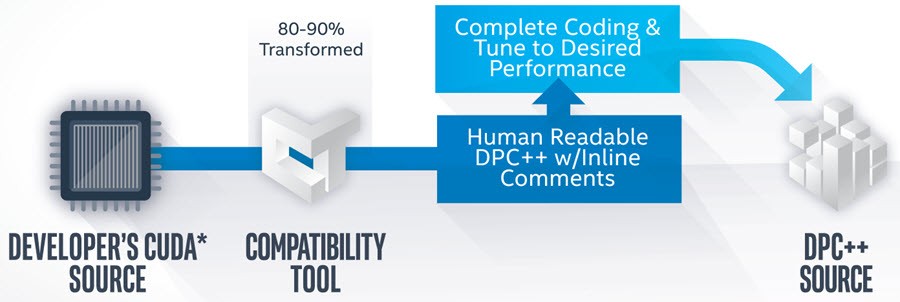Code written in other programming languages, such as C++ or OpenCL™, can be migrated to DPC++ code for use on multiple devices. The steps used to complete the migration vary based on the original language.
Migrating from CUDA TO DPC++
The Intel DPC++ Compatibility Tool is part of the Intel oneAPI Base Toolkit. The goal of this tool is to assist in the migration of an existing program that is written in NVIDIA* CUDA* to a program written in DPC++. This tool generates DPC++ code as much as possible. However, it will not migrate all code and manual changes may be required. The tool provides help with IDE plug-ins, a user guide, and embedded comments in the code to complete the migration to DPC++. After completing any manual changes, use a DPC++ Compiler to create executables.
Additional details, including examples of migrated code and download instructions for the tool, are available from the Intel® DPC++ Compatibility Tool website. Full usage information is available from the Intel® DPC++ Compatibility Tool User Guide.
Migrating from C++ to SYCL/DPC++
SYCL is a single-source style programming model based on C++. It builds on features of C++11 and has additional support for C++14 and enables C++17 Parallel STL programs to be accelerated on OpenCL™ devices. Some of the supported C++ features include templates, classes, operator overloading, lambda, and static polymorphism.
When accelerating an existing C++ application on OpenCL devices, SYCL provides seamless integration as most of the C++ code remains intact. Refer to sections within oneAPI Programming Model for SYCL constructs to enable device side compilation.
Migrating from OpenCL Code to DPC++
In the current version of DPC++, the runtime employs OpenCL code to enact the parallelism. DPC++ typically requires fewer lines of code to implement kernels and also fewer calls to essential API functions and methods. It enables creation of OpenCL programs by embedding the device source code in line with the host source code.
Most of the OpenCL application developers are aware of the somewhat verbose setup code that goes with offloading kernels on devices. Using DPC++, it is possible to develop a clean, modern C++ based application without most of the setup associated with OpenCL C code. This reduces the learning effort and allows for focus on parallelization techniques.
However, OpenCL application features can continue to be used via the SYCL API. The updated code can use as much or as little of the SYCL interface as desired.
Migrating Between CPU, GPU, and FPGA
In DPC++, a platform consists of a host device connected to zero or more devices, such as CPU, GPU, FPGA, or other kinds of accelerators and processors.
When a platform has multiple devices, design the application to offload some or most of the work to the devices. There are different ways to distribute work across devices in the oneAPI programming model:
-
Initialize device selector – SYCL provides a set of classes called selectors that allow manual selection of devices in the platform or let oneAPI runtime heuristics choose a default device based on the compute power available on the devices.
-
Splitting datasets – With a highly parallel application with no data dependency, explicitly divide the datasets to employ different devices.
- Target multiple kernels across devices – If the application has scope for parallelization on multiple independent kernels, employ different queues to target devices.



